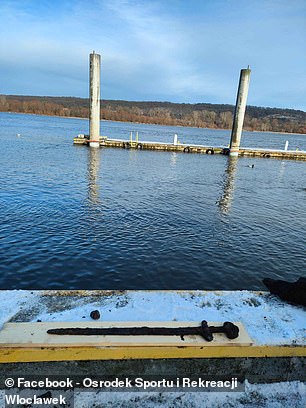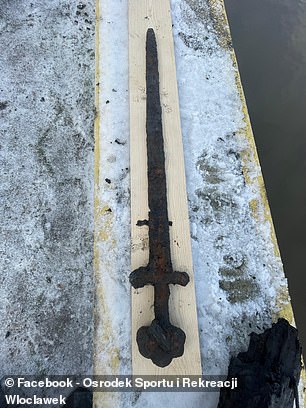Rare 1,000-year-old ‘Viking sword’ is discovered in near perfect condition on a river bed in Poland
- Workers carrying out dredging work in the Vistula River encountered the sword
- Archaeologists have now dated the weapon to before 950 AD
A rare 1,000-year-old ‘Viking sword’ has been found in near-perfect condition in a riverbed in Poland.
Workers carrying out dredging work in the Vistula River in the city of Wroclawek came across the “perfectly preserved” sword after spotting “an elongated, metallic object” emerging from the sediment.
Handing over the sword to researchers from Nicolaus Copernicus University in Torun, when archaeologists x-rayed the weapon and dated it to before 950 AD.
They also discovered an inscription with the word ‘Ulfberht’.
Only eight such swords are known in Poland and only 170 in the rest of Europe.
A rare 1,000-year-old ‘Viking sword’ has been found in near-perfect condition in a riverbed in Poland


Workers carrying out dredging work in the Vistula River in the city of Wroclawek came across the ‘perfectly preserved’ sword after spotting ‘an elongated, metallic object’ emerging from the sediment
Crafted using a process unknown to the Vikings’ rivals, the Ulfberht sword was a revolutionary high-tech sword and is considered one of the finest swords ever made.
The Ulfberht swords were known for their strength, flexibility and sharpness, and were highly prized by Viking warriors.
Sambor Gawiński from the Kuyavian-Pomeranian branch of the conservatory said: ‘This is an extremely valuable find.
‘We know that these so-called Ulfberht swords were produced somewhere in Central Europe, but where exactly is not known.
‘They are manufactured using very specific methods, using carbon steel and a very precise composition.
‘The amount of carbon steel used was strictly defined, making the sword very strong and flexible; its durability and combat value depended on it.”

During their analysis, the researchers also discovered an inscription with the word ‘Ulfberht’.

The incredible sword was discovered by workers in the Vistula River in the city of Wroclawek
He added: “More importantly, the sword has been preserved in excellent condition after being in the silt for more than a thousand years.”
With more than 40 such swords found in Norway, it is now widely believed that the recent find is also from the Viking era.
But Gawinski said: ‘Several theories have been put forward and so far all variants are acceptable, but we must wait for the results of more detailed research.’
Wojciech Sosnowski from the archeology department of the Provincial Office for the Protection of Monuments in Toruń told local news website Dzień Dobry Włocławek: ‘We are dealing with a very delicate and very valuable object.
‘The sword is in urgent need of preservation. The situation is dynamic, we are just gathering information about this object.’
